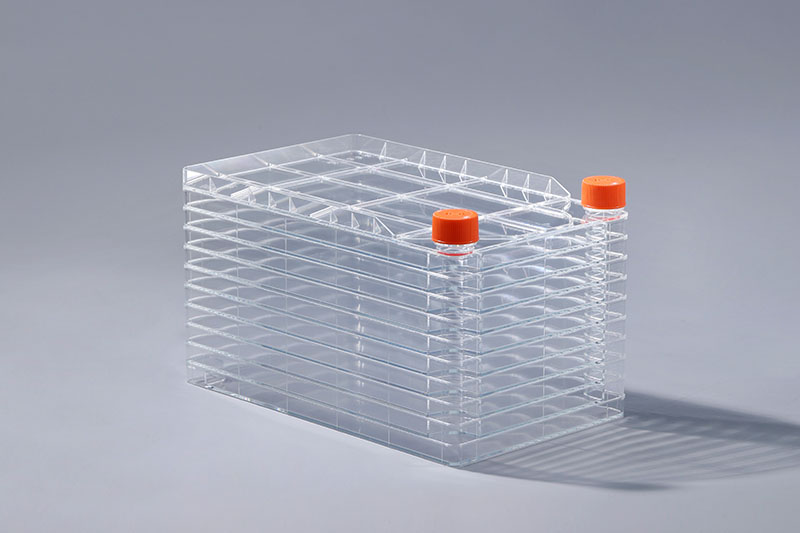Mae Lentivirus yn fath o fector firaol wedi'i addasu o firws imiwnoddiffygiant dynol (HIV), sy'n fath o retrovirus. Mewn arbrofion in vitro ac arbrofion in vivo, mae lentivirus wedi dod yn un o'r ffurfiau fectorau a ddefnyddir yn gyffredin ar gyfer mynegi genynnau alldarddol neu shRNA alldarddol, ac mae'n cael ei ddefnyddio'n fwyfwy eang. Yn ei gynhyrchiad màs, mae'rYn ogystal â chael ei gymhwyso i gynhyrchu fectorau lentifeirws ar raddfa fawr, mae ffatrïoedd celloedd yn chwarae rhan bwysig wrth gynhyrchu therapi celloedd ar raddfa fawr, therapi genynnau, therapi firws oncolytig , a brechlynnau. yn ddiwylliant cell traul a ddefnyddir yn gyffredin. dilyniannau. O ran heintusrwydd, gall heintio celloedd niwronaidd, hepatocytes, cardiomyocytes, celloedd tiwmor, celloedd endothelaidd, bôn-gelloedd a mathau eraill o gelloedd yn effeithiol, er mwyn cyflawni effeithiau therapi genynnau da. Ar gyfer rhai celloedd anodd eu trosglwyddo, megis celloedd cynradd, bôn-gelloedd, celloedd diwahaniaeth, ac ati, gall defnyddio fectorau lentiviral wella effeithlonrwydd trawsgludiad y genyn targed neu'r shRNA targed yn fawr, a gall y genyn targed neu'r shRNA targed cael ei integreiddio i'r gell gwesteiwr. Mae tebygolrwydd y genom yn cynyddu'n fawr, a gellir gwireddu mynegiant hirdymor a sefydlog y genyn targed neu'r shRNA targed yn fwy cyfleus a chyflym. Gall gynyddu arwynebedd diwylliant celloedd, a thrwy hynny gynyddu cynnyrch y fector, lleihau'r nifer o weithiau o drawsnewidiad ac ailosod cyfrwng ôl-drawsnewid, a lleihau costau llafur. Mae'n ddiwylliant celloedd effeithlon a chyfleus y gellir ei ddefnyddio.
Lentiviral vectors can effectively integrate exogenous genes or exogenous shRNAs into the host chromosome, so as to achieve the effect of persistently expressing target sequences. In terms of infectivity, it can effectively infect neuronal cells, hepatocytes, cardiomyocytes, tumor cells, endothelial cells, stem cells and other types of cells, so as to achieve good gene therapy effects. For some difficult-to-transfect cells, such as primary cells, stem cells, undifferentiated cells, etc., the use of lentiviral vectors can greatly improve the transduction efficiency of the target gene or target shRNA, and the target gene or target shRNA can be integrated into the host cell. The probability of the genome is greatly increased, and the long-term and stable expression of the target gene or target shRNA can be realized more conveniently and quickly.
The cell factory is mainly applied to the expanded production of lentiviral vectors. It can increase the surface area of cell culture, thereby increasing the yield of the vector, reducing the number of times of transfection and post-transfection medium replacement, and reducing labor costs. It is an efficient and convenient cell culture consumable.
In addition to being applied to the large-scale production of lentiviral vectors, cell factories play an important role in the large-scale production of cell therapy, gene therapy, oncolytic virus therapy, and vaccines.
The FAI climbed 5.9 percent year-on-year in the first 11 months of 2018, quickening from the 5.7-percent growth in Jan-Oct, the National Bureau of Statistics (NBS) said Friday in an online statement.
The key indicator of investment, dubbed a major growth driver, hit the bottom in August and has since started to rebound steadily.
In the face of emerging economic challenges home and abroad, China has stepped up efforts to stabilize investment, in particular rolling out measures to motivate private investors and channel funds into infrastructure.
Friday's data showed private investment, accounting for more than 60 percent of the total FAI, expanded by a brisk 8.7 percent.
NBS spokesperson Mao Shengyong said funds into weak economic links registered rapid increases as investment in environmental protection and agriculture jumped 42 percent and 12.5 percent respectively, much faster than the average.
In breakdown, investment in high-tech and equipment manufacturing remained vigorous with 16.1-percent and 11.6-percent increases respectively in the first 11 months. Infrastructure investment gained 3.7 percent, staying flat. Investment in property development rose 9.7 percent, also unchanged.
 English
English



















































